by Rick Bensene
Here's another wonderful piece of calculating history. This is a Wang Model 360SE Calculating System. Its not just a calculator, it's a system of calculators.
The 300-series of
calculators were the second line of electronic
calculators introduced by Wang. The LOCI (an acronym for
LOgarithmic Computing Instrument) machines, which
were rather clunky and large machines, were the first
electronic calculators sold by Wang, introduced in
January of 1965. The LOCI machine sold originally for
$6500, but could perform complex calculations with single
keystrokes (as compared to the complexities of making
mechanical calculators do the same calculation), in a
fraction of the time of older mechanical calculators, and
were significantly easier to use. The LOCI calculator
embodied Dr. Wang's logarithmic calculation circuit, and
proved to an eager marketplace that the electronic
calculator had a place in engineering and scientific
calculations. The LOCI machines today are extremely rare
and are generally considered museum pieces. |
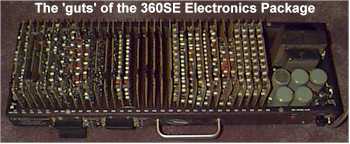 The
electronics package consists of a number of
standard-sized printed-circuit cards, which plug into
edge-card connectors, which are interconnected via a
hand-wired point-to-point backplane. The circuit cards
have components and traces on once side, and traces only
on the other side, with jumper wires providing
connections between sides of the board. In all of the
general circuitry of the machine, standardized components
are used. Most of the transistors are of the same type,
with exceptions in areas such as the timing and control
circuitry, core stack drivers and amplifiers, and display
driving circuits. The logic appears to be fairly generic
diode-resistor/transistor logic for gating functions, and
basic types of flip-flop circuits for registers,
counters, and latches. The
electronics package consists of a number of
standard-sized printed-circuit cards, which plug into
edge-card connectors, which are interconnected via a
hand-wired point-to-point backplane. The circuit cards
have components and traces on once side, and traces only
on the other side, with jumper wires providing
connections between sides of the board. In all of the
general circuitry of the machine, standardized components
are used. Most of the transistors are of the same type,
with exceptions in areas such as the timing and control
circuitry, core stack drivers and amplifiers, and display
driving circuits. The logic appears to be fairly generic
diode-resistor/transistor logic for gating functions, and
basic types of flip-flop circuits for registers,
counters, and latches. |
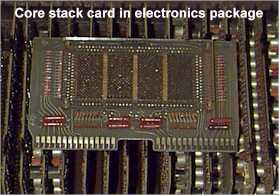 Core
memory is used for all of the working registers, with a
single PC card which has 4 small core arrays situated on
it, along with gating diodes. Another two or three boards
have the timing, driver, and amplifier circuitry to run
the core array. Core
memory is used for all of the working registers, with a
single PC card which has 4 small core arrays situated on
it, along with gating diodes. Another two or three boards
have the timing, driver, and amplifier circuitry to run
the core array.There were two versions of the 300-series electronics packages; the E model, and the SE model. The E-version of the machines provided one connector for plugging in a keyboard, and though you could, using special connectors, connect multiple keyboard/display units on these machines, only one keyboard/display unit could be used at a time. The SE-version machines provided four connectors for plugging in keyboard/display units, and all four keyboard/display units could operate at once as 'independent' calculators. There were four models available for each type of electronics package. It isn't clear (and I'd appreciate hearing if anyone knows for sure) if there were any differences at all in the electronics packages between the different models within a series (E or SE). It appears that the electronics package could have been the same between the 'low-end' 300E and the 'high-end' 360E, with the difference being the capabilities of the keyboard/display unit that came 'standard' with the machine. I'm not positive of this, though. The Model 300E system which was the 'base' model, came with the 300K keyboard/display unit, which provided access only to add, subtract, multiply, and divide functions |
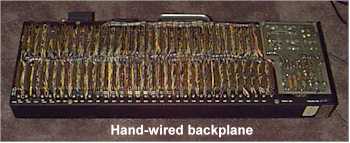 The
electronics package consists of a number of
standard-sized printed-circuit cards, which plug into
edge-card connectors, which are interconnected via a
hand-wired point-to-point backplane. The circuit cards
have components and traces on once side, and traces only
on the other side, with jumper wires providing
connections between sides of the board. In all of the
general circuitry of the machine, standardized components
are used. Most of the transistors are of the same type,
with exceptions in areas such as the timing and control
circuitry, core stack drivers and amplifiers, and display
driving circuits. The logic appears to be fairly generic
diode-resistor/transistor logic for gating functions, and
basic types of flip-flop circuits for registers,
counters, and latches. Core memory is used for all of the
working registers, with a single PC card which has 4
small core arrays situated on it, along with gating
diodes. Another two or three boards have the timing,
driver, and amplifier circuitry to run the core array. The
electronics package consists of a number of
standard-sized printed-circuit cards, which plug into
edge-card connectors, which are interconnected via a
hand-wired point-to-point backplane. The circuit cards
have components and traces on once side, and traces only
on the other side, with jumper wires providing
connections between sides of the board. In all of the
general circuitry of the machine, standardized components
are used. Most of the transistors are of the same type,
with exceptions in areas such as the timing and control
circuitry, core stack drivers and amplifiers, and display
driving circuits. The logic appears to be fairly generic
diode-resistor/transistor logic for gating functions, and
basic types of flip-flop circuits for registers,
counters, and latches. Core memory is used for all of the
working registers, with a single PC card which has 4
small core arrays situated on it, along with gating
diodes. Another two or three boards have the timing,
driver, and amplifier circuitry to run the core array.There were two versions of the 300-series electronics packages; the E model, and the SE model. The E-version of the machines provided one connector for plugging in a keyboard, and though you could, using special connectors, connect multiple keyboard/display units on these machines, only one keyboard/display unit could be used at a time. The SE-version machines provided four connectors for plugging in keyboard/display units, and all four keyboard/display units could operate at once as 'independent' calculators. There were four models available for each type of electronics package. It isn't clear (and I'd appreciate hearing if anyone knows for sure) if there were any differences at all in the electronics packages between the different models within a series (E or SE). It appears that the electronics package could have been the same between the 'low-end' 300E and the 'high-end' 360E, with the difference being the capabilities of the keyboard/display unit that came 'standard' with the machine. I'm not positive of this, though. |
  The Model
300E system which was the 'base' model, came with the
300K keyboard/display unit, which provided access only to
add, subtract, multiply, and divide functions. The Model
310E system provided the model 310K keyboard/display
unit, which added access to squaring and square root
functions. The Model
300E system which was the 'base' model, came with the
300K keyboard/display unit, which provided access only to
add, subtract, multiply, and divide functions. The Model
310E system provided the model 310K keyboard/display
unit, which added access to squaring and square root
functions. |
  The Model
320E system added to the 310's functions with addition of
e^X and Loge. The Model 360E system came with
the 360K keyboard/display unit, which added access to
four store/recall memory registers in addition to the
functions provided by the 320K keyboard/display unit. The Model
320E system added to the 310's functions with addition of
e^X and Loge. The Model 360E system came with
the 360K keyboard/display unit, which added access to
four store/recall memory registers in addition to the
functions provided by the 320K keyboard/display unit. |
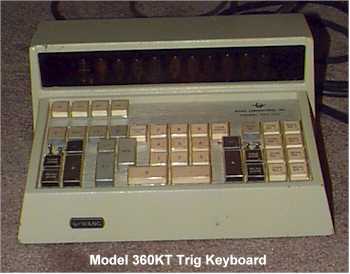 There was
a separate "SE" system available in each of the
300-series models. The "S" stood for
'Simultaneous'. The SE model electronics packages were
equipped with connectors for four keyboard/display units,
and they all operated as independent, simultaneous
calculators. There was
a separate "SE" system available in each of the
300-series models. The "S" stood for
'Simultaneous'. The SE model electronics packages were
equipped with connectors for four keyboard/display units,
and they all operated as independent, simultaneous
calculators.In the "SE" model machines, the electronics package 'timeshares' between each of the keyboard/display units, on a round-robin basis, with each 'slice' of time ending when an operation is completed, I.E.: if one keyboard/display unit is performing a calculation, the others are locked out until that operation completes, then the other units are given their slice of time. Generally, this time-slicing is performed quickly enough that it appears to each user as if they have their own dedicated calculator. The SE-series machines followed the same model-numbering scheme as the E-series machines, with the 300SE, 310SE, 320SE, and 360SE models being offered. This keyboard/display unit is the 'trig' unit, with a sequencing unit built into the keyboard unit that provides a ROM-based 'program' for calculating Sin, Cos, ArcSin, and ArcTan functions. The keys for these functions are at the upper-left of the keyboard. |
| .
|
| The 300-series machines
calculate to a full 14 digits of accuracy, but only
display 10 digits. This makes the machine very accurate.
Since the Wang calculators used logarithms to perform
multiplication and division, and even though Dr. Wang's
log-generating circuit produced very accurate results,
many are logs are transcendental numbers which can never
be represented with 100% accuracy no matter how many
digits you calculate them to. Therefore, the LOCI
machines, when doing multiplies and divides, could come
up with results which would be slightly off. An example
would be multiplying 6 by 8. The LOCI could give an
answer of 47.9999999. To make the 300-series more
intuitive, these machines got the benefit of a special
circuit that provided a 'round off' function, which would
cause such 6 x 8 to yield 48.0000000, which made the
300-series machine much more useful to 'non-technical'
(I.E.: business and financial) users. |
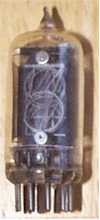 The display on the 300-series
machines is via Wang-manufactured "Nixie"
tubes. Nixie tubes display numbers by having ten
different stacked electrodes which are formed into the
shape of digits, all packed into a little glass envelope
which looks like a small vacuum tube, filled with neon
gas. When a given electrode is energized, the neon lights
up around the electrode, forming a glowing orange number.
Nixie tubes were commonly used in electronic equipment
requiring numeric output through the early '70's, when
other less complex (and expensive) display technologies
displaced them. An 11th special Nixie tube, situated to
the far left of the display, contained only a + and a -,
is used to indicate the sign of the result. Decimal
points are indicated by small discrete neon bulbs which
are situated between the Nixie tubes. The machine does
full-floating point math, which was rare for early
electronic calculators. Overflows result in the overflow
digits being discarded, and an 'overflow' neon bulb at
the far left of the display that blinks when a detected
overflow condition occurs. The display on the 300-series
machines is via Wang-manufactured "Nixie"
tubes. Nixie tubes display numbers by having ten
different stacked electrodes which are formed into the
shape of digits, all packed into a little glass envelope
which looks like a small vacuum tube, filled with neon
gas. When a given electrode is energized, the neon lights
up around the electrode, forming a glowing orange number.
Nixie tubes were commonly used in electronic equipment
requiring numeric output through the early '70's, when
other less complex (and expensive) display technologies
displaced them. An 11th special Nixie tube, situated to
the far left of the display, contained only a + and a -,
is used to indicate the sign of the result. Decimal
points are indicated by small discrete neon bulbs which
are situated between the Nixie tubes. The machine does
full-floating point math, which was rare for early
electronic calculators. Overflows result in the overflow
digits being discarded, and an 'overflow' neon bulb at
the far left of the display that blinks when a detected
overflow condition occurs. |
| The electronics package
provides two add/subtract accumulators (called the 'left'
and 'right' accumulators, based on their keys location
relative to the numeric keypad on the keyboard), 4 memory
store/recall registers, multiply, divide, square root,
X^2, Loge(X), and e^X functions for each
keyboard/display unit. It's up to the keyboard/display
unit to provide access to these functions. The machine used a unique method of entry for problems. Add and subtract operations were done in postfix form, I.E.:
Multiplication and division were performed using addition/subtraction of logarithms. Entering a number, followed by the "ENTER" key would cause the Loge of that number to be extracted and placed in a hidden register (not a stack, as in RPN style calculators). Entering the next number, followed by either the multiply or divide key, would cause the loge of the entered number to be extracted, then the result added (in the case of multiply) or subtracted (in the case of divide) to/from the hidden register, then the antiloge of the result extracted, and put into the display register. |
Source: Rick
Bensene's Old Calculators |